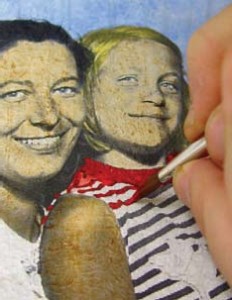By: Michael Townsend
The GOLDEN Digital Grounds, Gel Mediums and Archival Spray Varnishes have created options that will feel very familiar to photographers and are creating a platform for new alternatives for hands-on control of the final image.
Many photographers have in the past been able to use the darkroom as an additional stage for manipulating the image. Through various mechanics of light, filters, chemistry, substrate, and timing, artists had evolved both subtle and dramatic effects. In this digital environment, much of this control has been replaced with the control of the software and digital printers. With Digital Grounds, the artist again has physical control of the medium. The techniques for applying the Digital Grounds and making your own surfaces for these grounds are available on our Web site at mixmoremedia.com. There are also video resources showing how to create unique acrylic printing and painting surfaces as well as the “how-tos” for running these unique substrates through your printer.
 Blending Painting and Photography
Blending Painting and Photography
Creating the receptive surface by applying a Digital Ground allows the photographer total control over where the image is going to be transferred. Normally the digital ground is applied over the entire substrate, but it is also possible to apply the coating to just a select section of the substrate. This allows for several options: from creating a deckled watercolor paper- like feel to creating brushstroke patterns or passages in the printed image. After printing, the uncoated areas will result in a diffused print quality. By using different application tools and techniques, an unlimited variety of surfaces and photographic textures can be created.
 The Altered Image
The Altered Image
Altering the image after printing can be accomplished most easily on non-absorbent surfaces with Digital Ground for Non-Porous Surfaces. After applying this Digital Ground onto a glossy acrylic gel skin or other substrates such as foil, where the Digital Inks will dry fairly slowly, using water with a brush or rubbing the image with a cotton swab in water, will re-dissolve the image which can then be subtly moved or erased in areas, or bled into other areas of the piece. Photographers working in Polaroid® photography would be very familiar with this sort of treatment possibility. Please note that more absorbent papers, however, can be much harder to lift the inks from, especially when using pigmented inks that resist water. These images, like many of the other techniques described here and online in past issues of Just Paint (Issue #20) need to be protected with our Archival Spray Varnish to be able to seal the manipulated sensitive image to allow for continued painting on the surface of these pieces. A transparent image on gel can be both manipulated on the printed surface after sealing, but can also be painted on the reverse, non-printed side without sealing, similar to reverse painting on glass. In fact, images can be transferred onto both sides of these transparent surfaces, allowing for multiple levels of overlaid transparency, building up the image complexity like a multi-layered cake. Using multiple transparent layers, the image can be color separated, printed and combined to recreate the image.
 Direct Color Application
Direct Color Application
In this example, a black and white image is printed on a gel skin of cheesecloth and Coarse Molding Paste to create a canvas-like surface for the image. After printing, the image serves as an underpainting and then glazes (made from GOLDEN Fluid Acrylics and Acrylic Glazing Liquid) are applied to colorize the image. If transparency of the ground is desired, use Digital Ground Clear (Gloss), but realize it is much more water sensitive and a coating of MSA Varnish or Archival Varnish will be necessary to prevent the paints and mediums from adversely altering the print.
As photographers begin to explore the digital grounds and their combinations with all the tools of the painter, entirely new areas of discovery are clearly opened up and boundaries once thought sacrosanct will be broken through. The excitement is in seeing what will be accomplished.
About Michael Townsend
View all posts by Michael Townsend -->Subscribe
Subscribe to the newsletter today!
No related Post



